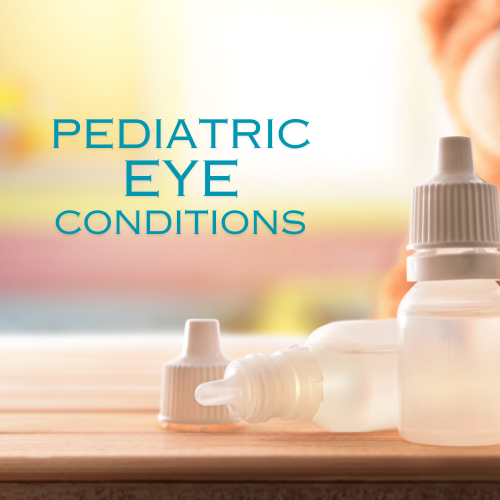Pediatric Eye Conditions


Pediatric eye conditions are those eye problems that occur in children. Some are common, some not so common, some are benign and some can be signs of serious health issues.
Vision is a vital part of a child’s development. During the early years of life, the visual system undergoes rapid growth and maturation. Early detection and correction of vision problems help ensure that a child’s visual system develops optimally.
Early detection and prompt intervention are crucial for many eye conditions in children, because some conditions that are left untreated can lead to vision problems or even permanent vision loss. Be attentive to signs of eye issues in your child, such as changes in vision, eye alignment problems, or unusual eye appearances, and seek professional evaluation when needed.
The following are eye conditions that can occur in young children. The incidence of each condition can vary and their frequency may depend on factors such as geographic location, genetics, and access to healthcare. Some conditions are relatively common, while others are rare.
Refractive Errors (Nearsightedness, Farsightedness, Astigmatism): Refractive errors are relatively common in children. According to the American Academy of Ophthalmology, around 25% of school-aged children in the United States have some form of refractive error. The visual system is most responsive to treatment during childhood.
The earlier refractive errors are corrected, the more likely it is for a child to achieve normal or near-normal vision and minimize long-term visual problems. Untreated refractive errors are one of the most common causes of vision loss in children in the US and across the world. If refractive errors are not treated with glasses or contact lenses early enough in life, a child can be left with permanently blurred vision in adulthood
Amblyopia (Lazy Eye): Amblyopia is also relatively common, affecting about 2-3% of children. Early diagnosis and treatment are essential to prevent vision impairment.
Strabismus (Crossed or Misaligned Eyes): Strabismus is seen in approximately 2-4% of children. It can vary in severity and may require intervention to correct eye alignment.
Conjunctivitis (Pink Eye): Conjunctivitis can be common, particularly in childcare settings. The prevalence may increase during outbreaks of viral or bacterial conjunctivitis.
Blocked Tear Ducts: Blocked tear ducts are common in infants, occurring in about 5-20% of newborns. Most cases resolve without intervention, but some may require treatment.
Ptosis (Drooping Eyelid): Ptosis can occur in children, although it is less common than in adults. The prevalence varies depending on the underlying cause.
Allergic Eye Conditions: Allergic eye conditions, such as allergic conjunctivitis, can affect a significant number of children, especially those with allergies. The prevalence may vary based on the prevalence of allergies in the population.
Pediatric Cataracts: Pediatric cataracts are relatively rare but can occur in children at birth (congenital cataracts) or develop during childhood. The incidence is about 1 to 6 out of every 10,000 live births.
Retinoblastoma: Retinoblastoma is an extremely rare eye cancer that primarily affects young children, typically under the age of five. Its prevalence is estimated to be around 1 in 15,000 to 20,000 live births.
Regular eye examinations are essential for monitoring a child’s visual development, detecting refractive errors, eye conditions, and other issues early, and ensuring that any necessary interventions or treatments are initiated promptly.
Seek immediate evaluation by an eye care specialist if your child exhibits any signs or symptoms of vision problems, such as squinting, eye rubbing, frequent headaches, red or watery eyes, or difficulty focusing.
Gregory Scimeca, M.D.
Ophthalmologist and Medical Director
The Eye Professionals
Our Locations
